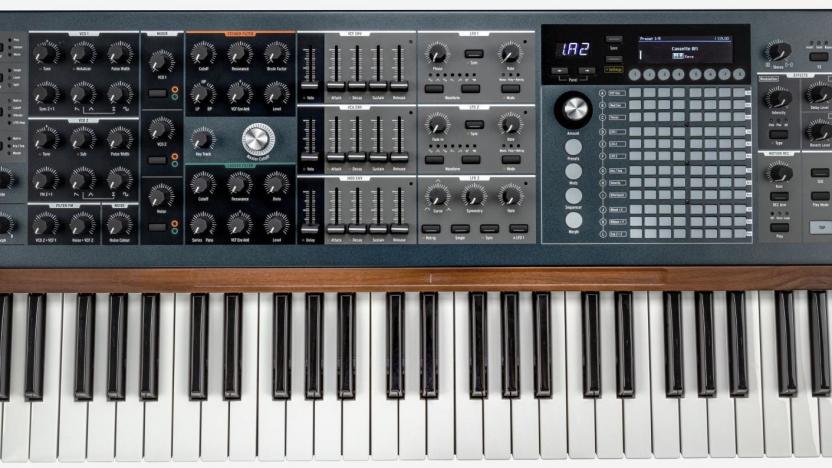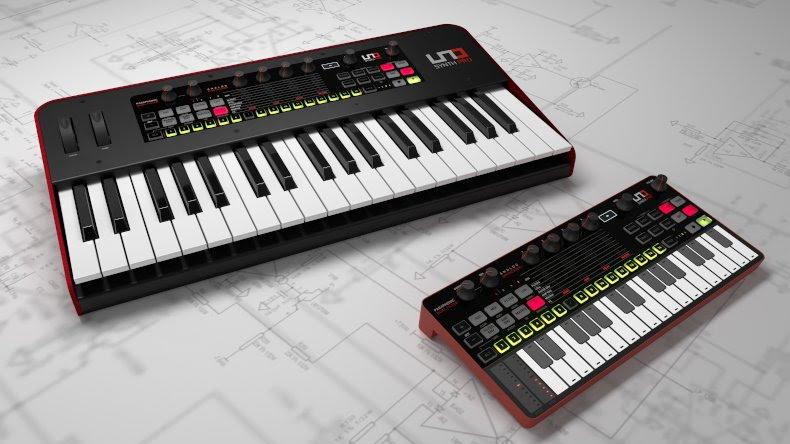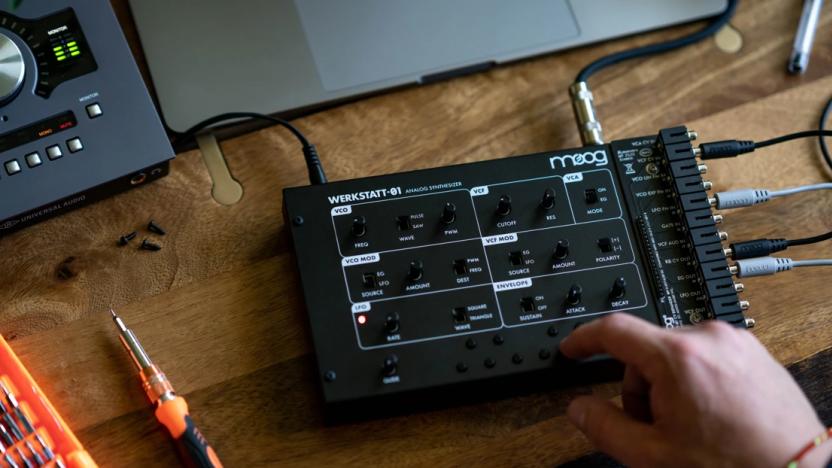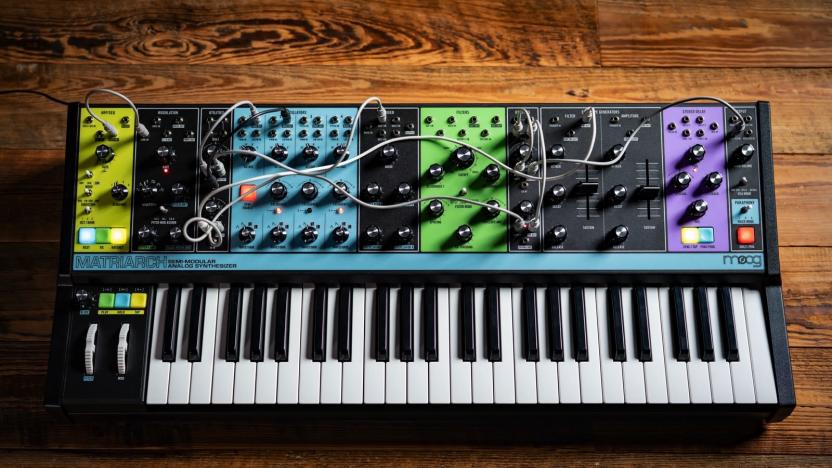analog synth
Latest

Arturia's flagship PolyBrute synth is shipping now
Arturia’s $2,899 PolyBrute isn’t for the faint of heart. But it’s definitely gotten the synth nerd world all worked up. Now the first batch are shipping world wide and will be in the hands of eager users soon enough.

Uno Synth Pro is IK Multimedia's attempt to move beyond budget instruments
IK Multimedia is stretching its wings yet again, this time with the Uno Synth Pro. This three-oscillator paraphonic instrument goes well beyond the portable and affordable Uno Synth and looks to carve out space among higher-end competition like Korg and Moog.

Moog's Werkstatt-01 synth is back and it's more affordable than ever
The easy-to-assemble kit costs $199, but it's only available for a limited time.

Arturia's PolyBrute is a beastly analog synth with infinite control
The PolyBrute is a six-voice analog beast that combines Arturia’s signature mod matrix with its digital effects expertise and a some innovative controls in a true polyphonic instrument.

The synth tones of 'Blade Runner' now fit on your desk
Yamaha's CS-80 is one of the biggest synths ever -- whether in size, tone or resale price. Most notably remembered for being Vangelis' go-to instrument when composing the score for Blade Runner, the 220-pound behemoth sells for over $20,000 on the secondhand market. Black Corporation designed a replicant of the CS-80 a few years ago, and though it wowed musicians, its bulky rackmount format was a turnoff. Deckard's Dream MK2 shrinks the synth down into a desktop format, which will be easier for bedroom producers to integrate into their studios.

The Moog Subsequent 25 offers classic synth bass with modern amenities
Anytime Moog releases a new synth it's worth getting at least a little excited about. And the Subsequent 25 (or Sub 25) is no exception. It's the successor to the Sub Phatty -- basically the standard bearer for classic Moog bass sounds over the last several years. The Sub 25 takes what made its predecessor such a powerful and aggressive tone monster and just goes bigger.

Behringer’s Poly D stacks four Moog clones in one synth
Behringer has a reputation for producing clones of classic synthesizers that are a little too similar to the originals. While these low-priced units help musicians get faithful, analogue reproductions of prohibitively expensive vintage keyboards, Behringer's strategy of using the same schematics as the originals rubs some purists the wrong way. Announced today, the company's Poly D makes it seem like the manufacturer could be shifting gears and taking some artistic liberties when it comes to reinterpreting old instruments. The unit is similar to Moog's Minimoog Model D -- which Behringer has already cloned -- but adds several features that make it a much more flexible synth.

Moog introduces the Matriarch: A four-voice semi-modular analog synth
Like it has in years past, Moog is unveiling its latest synthesizer during Moogfest. The company's annual music and culture festival kicks off today in Durham, North Carolina, and when it does, Moog will be building the new Matriarch patchable four-note paraphonic analog synth on-site. A progression from the Mother-32 and Grandmother before it, the semi-modular Matriarch is loaded: built-in sequencer (256 steps), arpeggiator, stereo ladder filters and stereo analog delay. The company says you'll be able to make some noise instantly though, with "no patching required."

KORG Monotron analog ribbon synths: Fun pocket-sized music accessories
KORG has been manufacturing amazing electronic instruments since 1963, and now it's developed the Monotron line of pocketable analog ribbon synthesizers that can work with your favorite Mac or iOS music-making apps. These pocket wonders are useful for adding a classic electronic touch to your live performances as well. To give you a feel for all three of the Monotron synths, there's a video at the end of this post. Read along for a quick hands-on review of the original Monotron. Analog synthesizers like the Monotron use a voltage-controlled oscillator (VCO) to generate a tone, a low-frequency oscillator (LFO) to create a rhythmic pulse or sweep, and a voltage-controlled filter to vary the cutoff frequency of the oscillator. The touch-sensitive ribbon on the Monotron is used to vary the pitch of the sounds being generated, and there are five adjustable potentiometers to adjust pitch, LFO rate and interval, and the VCF cutoff and peak. For those of you who understand circuit diagrams, here's how the Monotron is set up: Sure, you could buy the parts and build an analog synth yourself, but for US$59.99 you can get a Monotron pre-made and ready to rock. All of the Monotron units are powered by a pair of AAA batteries. The original Monotron has a volume control, AUX jack for input, and a headphone jack plus a built-in speaker. I decided to test the Monotron with GarageBand on my iMac, using a standard 1/4" line from the headphone jack to an iMic connected via USB. The sound came in nicely, and I recorded a short sample (below) of the hypnotic effects you can get from an analog synth. I played with analog synths in the mid-1970s and built two from the kits that were available at the time, but this was much more fun! (Direct link here) You can also take sound from GarageBand or other instruments, run it through the Monotron, then pass that along to your speakers or recording setup. Whether you use the Monotron output as a backing track on a GarageBand recording, use it for providing a musical beat in live performance, or use the Monotron to process other sounds, it's an inexpensive and fun way to explore electronic music. Check out the video below to see the other Monotron synths in action.

Korg Monotribe has 1978 sound, modern mobility (video)
Meet the latest in Korg's analog revival, dubbed the Monotribe -- a portable, battery-powered groovebox with an old heart. This eight step sequencer expands on last year's Monotron, using the same classic Korg M-10 plus M-20 analog filters and ribbon keyboard as its older, pocket-sized brother. The new unit kicks it up a notch with expanded VCO, VCA, VCF, and LFO controls, as well as three-part analog drums. It's also said to last up to 14 hours on six AA batteries, so you can take your beats to the beach or simply drive your neighbors batty; it's nice to have options. Check out the demo video above, or the hit press release after the break for details.

Korg debuts pocket-sized Monotron analog synth, and we want it (video)
Don't take this the wrong way -- we're glad to be in Las Vegas with all our friends at CTIA, playing with new handsets from Samsung and Motorola. But as you know, we also love us some new music gear, especially when it sounds good -- so we wouldn't exactly mind being in Frankfurt for Musikmesse right now, either. Currently on display at Korg's booth, Monotron is a two AAA-powered, pocket-sized analog synth featuring a ribbon keyboard, VCO, VCF, and LFO controls, and the same analog filter found in the Korg MS-10 and MS-20 -- and it sounds great. Check it out in the gallery below and in the video after the break to see / hear the thing in action. Look for it in May for about $67. %Gallery-88925%

Yoshi Akai's Wireless Catcher senses nearby wireless waves, makes music (video)
What's cute, cuddly, and makes all sorts of bizarro noises when it senses wireless waves? Yoshi Akai's Wireless Catcher, of course! This analog synth contraption is simplistic in nature and complex in design, utilizing an onboard antenna to sense WiFi signals and then alter the sounds being outputted depending on signal strength and direction. It's not exactly the symphony that Bach forgot to write, but it's certainly beautiful in its own nerdy way. Have a look at the video past the break, won't you?

Dave Smith's Mopho keyboard prototype wows analog fanboys at NAMM (video)
Dave Smith's name is as revered in the synth business as those of Tom Oberheim and "Handsome Ron" Casio. Having had his hands in everything from the Prophet 5 synth to developing the MIDI specification to his own company (Dave Smith Instruments), the man has given electronic musicians plenty to be thankful for. The boutique's latest, the Mopho Keyboard (seen here in prototype form at NAMM 2010) takes the existing Mopho synth module -- a pretty sweet deal with its sub-octave generators, audio input (you know, for modulating stuff), and feedback options -- and adds a thirty-two key keyboard and a whole mess of controls. Like original, this new Mopho has a 100 percent analog signal path, ships with a sound bank editor for both Windows and Mac, and it sounds pretty, pretty bad ass. Look for it in the near future for around $800. Video after the break.

Thingamagoop: the synth with personality
Meet Thingamagoop. Like regular analog synthesizers, this Bleep Labs creation emits all sorts of wild, far-out sounds, but unlike most other synths, its main oscillator is controlled by a photocell instead of the usual keyboard -- frequency is adjusted by turning the main knob, and the type of modulation is selected by toggling the device's, um, nipples. Okay, we're cool with non-traditional input methods, but why endow this $100 handmade model with such a creepy-looking face? "Because there are not nearly enough beeping, zapping, bixxerfouping, anthropomorphic synthesizer monsters in the world," according to the creators. How very true.[Via Music Thing]






